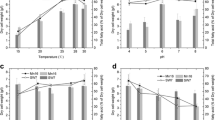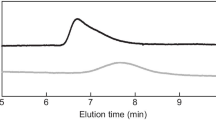Abstract
Crypthecodinium cohnii, a marine alga used for the commercial production of docosahexaenoic acid (DHA), was cultivated in medium containing sodium acetate as principal carbon source; the pH was maintained at a constant value by addition of acetic acid, which also provided an additional carbon source in a controlled manner. The accumulation of lipid by C. cohnii in this pH-auxostat culture was significantly greater than previously reported for batch cultures using glucose as principal carbon source. Of six strains tested in pH-auxostat cultures, C. cohnii ATCC 30772 was the best, with the cells reaching 20 to 30 g dry weight per liter after 98 to 144 h and containing in excess of 40% (w/w) total lipid, with DHA representing approximately half of the total fatty acids in the triacylglycerol fraction. A productivity of 36 mg DHAL−1 h−1 was achieved during cultivation for 98 h using a 5% (vol/vol) inoculum, and DHA production was in excess of 3 g per liter of culture. Most of the DHA was present in neutral lipids.
Similar content being viewed by others
Abbreviations
- ATCC:
-
American Type Culture Collection
- DHA:
-
docosahexaenoic acid
- EPA:
-
eicosapentaenoic acid
- GC:
-
gas chromatography
- TLC:
-
thin-layer chromatography
- vvm:
-
volume of air/volume of medium/min
References
Carlson, S.E. (1995) The Role of PUFA in Infant Nutrition, Inform 6, 940–946.
Gurr, M.I. (1997) Lipids in Infant Nutrition, Lipid Technol. 9, 14–17.
Huang, Y.S., and Sinclair, A.J. (1998) Lipids in Infant Nutrition, AOCS Press, Champaign.
Health & Welfare Canada (1991) Nutritional Recommendations, pp. 40–45, 203, Dept. of Health & Welfare, Ottawa, Canada.
British Nutrition Foundation (1992) Unsaturated Fatty Acids: Nutritional and Physiological Significances, Chapman and Hall, London.
Nichol, W.M. (1992) Nutritional and Physiological Significance of Unsaturated Fatty Acids, Food Safety Notebook 3, 57–58.
Ykema, A., Verbree, E.C., van Verseveld, H.W., and Smit, H. (1986) Mathematical Modelling of Lipid Production by Oleaginous Yeasts in Continuous Cultures, Ant. van Leeuwenhoek 52, 491–506.
Ratledge, C. (2001) Microorganisms as Sources of Polyunsaturated Fatty Acids, in Structured and Modified Lipids (Gunstone, F., ed.) pp. 351–399, Marcel Dekker, New York.
Singh, A., and Ward, O.P. (1997) Microbial Production of Docosahexaenoic Acid (DHA, C22∶6), Adv. Appl. Microbiol. 45, 271–312.
Shahidi, F., and Wanasundara, U.N. (1998) Omega-3 Fatty Acid Concentrates: Nutritional Aspects and Production Technologies, Trends Food. Sci. Technol. 9, 230–240.
Harrington, G.W., and Holz, G.G. (1968) The Monoenoic and Docosahexaneonic Fatty Acids of a Heterotrophic Dinoflagellate, Biochim. Biophys. Acta 164, 137–139.
Kyle, D.J. (1992) Production and Use of Lipids from Microalgae, Lipid Technol. 4, 59–64.
Kyle, D.J. (1996) Production and Use of a Single Cell Oil Which Is Highly Enriched in Docosahexaenoic Acid, Lipid Technol. 8, 107–110.
Kyle, D.J., Behrens, P., Bingham, K., Arnett, K., and Lieberman, D. (1998) Microalgae as a Source of EPA-Containing Oils, in Biotechnology for the Fats and Oils Industry (Applewhite, T.H., ed.) pp. 117–122, AOCS Press, Champaign.
Kyle, D.J. (1994) Microbial Oil Mixtures and Uses Thereof. Martek Corporation, U.S. Patent 5,374,657.
Kyle, D.J., Reeb, S.E., and Sicotte, V.J. (1995) Infant Formula and Baby Food Containing Docosahexaenoic Acid Obtained from Dinoflagellates, Martek Biosciences Corporation, U.S. Patent 5,397,591.
Kyle, D.J., Reeb, S.E., and Sicotte, V.J. (1998) Docosahexaenoic Acid, Methods for Its Production and Compounds Containing the Same, Martek Corporation, E.U. Patent 0515460B1.
Vazhappilly, R., and Chen, F. (1998) Eicosapentaenoic Acid and Docosahexaenoic Acid Production Potential of Microalgae and Their Heterotrophic Growth, J. Am. Oil Chem. Soc. 75, 393–397.
Martin, G.A., and Hempfling, W.P. (1976) A Method for the Regulation of Microbial Population Density During Continuous Culture at High Growth Rates, Arch. Microbiol. 107, 41–47.
du Preez, J.C., Immelman, M., Kock, J.L.F., and Kilian, S.G. (1997) The Effect of Acetic Acid Concentration on the Growth and Production of γ-Linolenic Acid by Mucor circinelloides CBS 203.28 in Fed-Batch Culture, World J. Microbiol. Biotechnol. 13, 81–87.
Folch, J., Lees, M., and Sloane Stanley, G.H. (1957) A Simple Method for the Isolation and Purification of Total Lipides from Animal Tissues, J. Biol. Chem. 226, 497–509.
Christie, W.W. (1991). Solid-Phase Extraction Columns in Lipid Analysis, Lipid Technol. 3, 31–33.
Kates, M. (1972) Techniques of Lipidology, North-Holland, Amsterdam.
Butte, W. (1983) Rapid Method for the Determination of Fatty Acid Profiles from Fats and Oils Using Trimethylsulfonium Hydroxide for Transesterification, J. Chromatogr. 261, 142–145.
Wynn, J.P., and Ratledge, C. (2000) Evidence That the Rate-Limiting Step for the Biosynthesis of Arachidonic Acid in Mortierella alpina Is at the Level of the 18∶3 to 20∶3 Elongase, Microbiology 146, 2325–2331.
De Swaaf, M.E., de Rijk, T.C., Eggink, G., and Sijtsma, L. (1999) Optimisation of Docosahexaenoic Acid Production in Batch Cultivations by Crypthecodinium cohnii, J. Biotechnol. 70, 185–192.
Henderson, R.J., Leftley, J.W., and Sargent, J.R. (1988) Lipid Composition and Biosynthesis in the Marine Dinoflagellate Crythecodinium cohnii, Phytochemistry 27, 1679–1683.
De Swaaf, M.E., Grobben, G.J., Eggink, G., de Rijk, T.C., van der Meer, P., and Sijtsma, L. (2001) Characterisation of Extracellular Polysaccharides Produced by Crypthecodinium cohnii. Appl. Microbiol. Biotechnol. 57, 395–400.
Author information
Authors and Affiliations
Corresponding author
About this article
Cite this article
Ratledge, C., Kanagachandran, K., Anderson, A.J. et al. Production of docosahexaenoic acid by Crypthecodinium cohnii grown in a pH-auxostat culture with acetic acid as principal carbon source. Lipids 36, 1241–1246 (2001). https://doi.org/10.1007/s11745-001-0838-x
Received:
Revised:
Accepted:
Issue Date:
DOI: https://doi.org/10.1007/s11745-001-0838-x




